Papers by Sabina Jhaumeer-laulloo
Acta Crystallographica Section E Structure Reports Online, 2008
An entry from the Cambridge Structural Database, the world's repository for small molecule cr... more An entry from the Cambridge Structural Database, the world's repository for small molecule crystal structures. The entry contains experimental data from a crystal diffraction study. The deposited dataset for this entry is freely available from the CCDC and typically includes 3D coordinates, cell parameters, space group, experimental conditions and quality measures.
An entry from the Cambridge Structural Database, the world's repository for small molecule cr... more An entry from the Cambridge Structural Database, the world's repository for small molecule crystal structures. The entry contains experimental data from a crystal diffraction study. The deposited dataset for this entry is freely available from the CCDC and typically includes 3D coordinates, cell parameters, space group, experimental conditions and quality measures.
An entry from the Cambridge Structural Database, the world's repository for small molecule cr... more An entry from the Cambridge Structural Database, the world's repository for small molecule crystal structures. The entry contains experimental data from a crystal diffraction study. The deposited dataset for this entry is freely available from the CCDC and typically includes 3D coordinates, cell parameters, space group, experimental conditions and quality measures.
An entry from the Cambridge Structural Database, the world's repository for small molecule cr... more An entry from the Cambridge Structural Database, the world's repository for small molecule crystal structures. The entry contains experimental data from a crystal diffraction study. The deposited dataset for this entry is freely available from the CCDC and typically includes 3D coordinates, cell parameters, space group, experimental conditions and quality measures.
ChemInform, May 1, 2001
A series of macrocycl ic dilactams containing a disulphide bridge has been synthesized by the con... more A series of macrocycl ic dilactams containing a disulphide bridge has been synthesized by the condensation of 2,2'-'dithiodibenzoyl chloride with diamines. These compounds have been evaluated for their ability to inh;bit reverse transcriptase (RT) of the human immunodeficiency virus HIV-1 (lll 8) and HIV-2 (ROD) in acute) y infected MT-4 cell s. The anti-HIV activity of these compounds depends on the ring size and al so on the diamino counterpart. The dil actams with 12-membered rings 1 and 5 were found to be the most potent. The acti ve analogues 1 and 5 inhibit the repli cati on of HIV-1 (111 8) and HIV-2 (ROE>) with an EC 50 between 1.2 to 4.4 J.lg/mL The dilactam 7 shows comparable activity inC 8 166 cells.
again stable only under these extreme conditions and disappears immediately on removal of the liq... more again stable only under these extreme conditions and disappears immediately on removal of the liquid nitrogen coolant. Irradiation products are the hydrocarbon (5) and the pyridazine (6) (yield >90%). Since (6) absorbs at 258.5 nm (in ether) and a charge-transfer complex with tetramethylcyclobutadiene (7) is unlikely, the maximum at 375 nm observed on low-temperature irradiation of (4) must be assigned to "free" tetramethylcyclobutadiene (7).
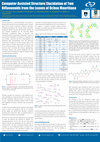
Planta medica international open, Oct 1, 2017
HR-ESI-MS recorded for compound 1 (m/z 539.0953 [M-H]-, calcd. 539.0978) and compound 2 (m/z 553.... more HR-ESI-MS recorded for compound 1 (m/z 539.0953 [M-H]-, calcd. 539.0978) and compound 2 (m/z 553.1116 [M-H]-, calcd. 553.1135) established molecular formulas of C 30 H 20 O 10 and C 31 H 22 O 10 , respectively. Preliminary analysis of their 1D NMR data suggested that these compounds were flavonoid-type molecules. In order to limit the possibility that the compounds were already known, a search was performed using the 13 C recorded spectra against the ACD/Structure Elucidator compound database which contains 95+ million 13 C predicted spectra of compounds from PubChem and ChemSpider. The search for compound 1 took around 30 sec and produced 10 results. The molecule with PubChem ID 10437291, 2',3'-Dihydroochnaflavone, was the one with the lowest mean deviation between the experimental and the predicted 13 C chemical shift of 1.277 ppm. The literature reference cited by PubChem 3 as well as references therein 4,5 contained the 1 H and 13 C NMR spectra of the compound in DMSO-d 6 and acetone-d 6 which were in agreement with our results.
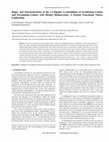
Current Organic Chemistry, Jun 1, 2012
Theoretical computations were performed on the 1,3-dipolar cycloaddition reactions of pyridinium-... more Theoretical computations were performed on the 1,3-dipolar cycloaddition reactions of pyridinium-3-olates and pyrazinium-3olates with methyl methacrylate employing density functional theory at the B3LYP/6-31G(d) level in the gas phase and in THF. The two possible regioisomeric pathways, forming 6-esters and 7-esters, along with the two stereoisomeric channels, endo and exo, have been considered. Thermodynamic and kinetic parameters calculated at room temperature have been analyzed while the regioselectivity has been interpreted using reactivity indices. The presence of the methyl group on the dipolarophile compared to methyl acrylate, increases the activation energy but decreases the reaction enthalpy in THF. The rate constants of these reactions have been determined using conventional transition state theory. The thermodynamic and kinetic preferences for the reactions of these pyridinium-3-olates and pyrazinium-3-olates with methyl methacrylate, in the gas phase and THF, decrease in the order 6-exo > 7-exo > 6-endo > 7-endo. On comparing the reactions of pyridinium-3-olates and pyrazinium-3-olates with methyl acrylate, a different order is observed although the 6-exo cycloadduct remains the major product.
Bulletin of the Chemical Society of Ethiopia, 2018
The effect of a range of O-alkyl ester hydrochloride surfactants derived from L-phenylalanine and... more The effect of a range of O-alkyl ester hydrochloride surfactants derived from L-phenylalanine and L-tyrosine as catalysts on the Diels-Alder reaction between cyclopentadiene and methyl acrylate was studied. Both chain lengths (C8-C14) and head groups of the surfactants were found to influence the yield and selectivity of the Diels-Alder product. The C10 derivatives of both phenylalanine and tyrosine surfactants gave the highest yields and selectivity. Phenylalanine ester hydrochlorides showed better catalytic activity than the tyrosine derivatives. Adduct optimum yield was obtained at a concentration relating to their critical micelle concentration (CMC) values. The Diels-Alder reaction was also found to be favored in acidic condition (pH 3) as well as in the presence of lithium chloride (LiCl) as salting out agent.
Journal of Molecular Structure
Transition Metal Chemistry, 2015
The powder X-ray diffraction pattern, describing compounds 2, given in Fig. 5, is in fact the pow... more The powder X-ray diffraction pattern, describing compounds 2, given in Fig. 5, is in fact the powder X-ray diffraction pattern for compounds 3 (Fig. 7) and vice versa. The correct powder X-ray patterns are given below.
The use of general descriptive names, registered names, trademarks, service marks, etc. in this p... more The use of general descriptive names, registered names, trademarks, service marks, etc. in this publication does not imply, even in the absence of a specific statement, that such names are exempt from the relevant protective laws and regulations and therefore free for general use.

Applied Catalysis B: Environmental, 1994
The International Conference on Pure and Applied Chemistry (ICPAC 2010) was held from 26th to 30t... more The International Conference on Pure and Applied Chemistry (ICPAC 2010) was held from 26th to 30th July 2010 at La Plantation Resort and Spa, Balaclava, in Mauritius. The theme of the conference was "Chemistry for Sustainable Development". ICPAC 2010 was attended by about 160 participants coming from 30 countries. The conference featured 100 oral and 85 poster presentations. The participants of ICPAC 2010 were invited to submit full papers. The latter were subsequently peer reviewed and the selected papers are collected in this volume. This book of proceedings encloses 31 presentations covering wide ranging topics from organic chemistry to material science and nanotechnology, and from computational chemistry to agricultural chemistry. We would like to thank all those who submitted the full papers and the reviewers for their timely help in assessing these papers for publication. We would like to pay a special tribute to all the sponsors of ICPAC 2010. Chemistry is being increasingly recognised as a central discipline that encompasses several areas of medicine, agriculture, biology, environment, physics and material science. Therefore, as we celebrate the International Year of Chemistry (IYC 2011) and the 100th anniversary of the Noble prize awarded to Marie Curie, we hope that this collection of papers will serve as a useful reference set for researchers.
An entry from the Cambridge Structural Database, the world's repository for small molecule cr... more An entry from the Cambridge Structural Database, the world's repository for small molecule crystal structures. The entry contains experimental data from a crystal diffraction study. The deposited dataset for this entry is freely available from the CCDC and typically includes 3D coordinates, cell parameters, space group, experimental conditions and quality measures.
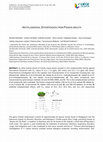
Journal of Natural Products, 2019
An ethyl acetate extract of Psiadia arguta leaves showed in vitro antiplasmodial activity against... more An ethyl acetate extract of Psiadia arguta leaves showed in vitro antiplasmodial activity against Plasmodium falciparum with IC50 values of 12.3 ± 2.4 µg∕ mL (3D7 strain) and 13.5 ± 3.4 µg∕ mL (W2 strain). Phytochemical investigation led to the isolation and characterization of 16 compounds including four new diterpenoids: labdan-8α-ol-15-yl-(formate) (1), labdan-8α-ol-15-yl-(2-methylbutanoate) (2), labdan-8α-ol-15yl-(3-methylpentanoate) (3), and labdan-8α-ol-15-yl-(labdanolate) (4). The latter compounds were characterized by spectroscopic methods (1D and 2D NMR, HRMS, and IR). The in vitro antiplasmodial activities of all compounds were evaluated. The known compounds labdan-13(E)-en-8α-ol-15-yl acetate (5), labdan-8αol-15-yl acetate (6), 13-epi-sclareol (7), labdan-13(E)-ene-8α,15-diol (8), and (8R,13S)-labdane-8α,15-diol (9) exhibited antiplasmodial effects, with IC50 values of 29.1, 33.2, 35.0, 36.6, and 22.2 µM, respectively The genus Psiadia (Asteraceae) consists of approximately 60 species mainly found in Madagascar and the Mascarene Islands (La Reunion, Mauritius, and Rodrigues). 1 Psiadia arguta (Pers.) Voigt, commonly known as "Baume de l'île Plate", is endemic to Mauritius and can be found on Ilot Gabriel, a small islet off Mauritius's north coast. This species is used traditionally for treatment of pulmonary infections, respiratory disorders, cough, and indigestion and is also employed to heal minor wounds and burns. 2,3 Previous pharmacological investigations of P. arguta extracts revealed several biological properties including antimicrobial, 4 anti
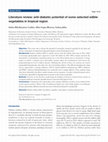
Longhua Chinese Medicine, 2021
This review aims to discuss the potential of commonly consumed vegetables by the Asian and Africa... more This review aims to discuss the potential of commonly consumed vegetables by the Asian and African communities of tropical and subtropical regions to lower blood glucose level. Background: Diabetes mellitus (DM) is a global concern with 463 million adult cases in 2019, which is increasing exponentially and is expected to reach 700 million by 2045. DM is mainly caused by the abnormality of carbohydrate metabolism giving rise to low blood insulin level or insensitivity of target organs to insulin. α-Amylase and α-glucosidase enzymes digest the carbohydrates and increase the postprandial glucose level in diabetic patients. Inhibiting the activity of these two enzymes can control postprandial hyperglycemia and reduce the risk of developing diabetes. The different hypoglycemic drugs such as α-glucosidase, α-amylase inhibitors, ATP-K + channel inhibitors (sulfonylureas), DPP-4 inhibitors and PPAR-γ activators (thiazolidinediones) are commonly used to manage diabetes. These synthetic drugs often show undesirable side effects, insulin resistance and are expensive. A number of phytochemicals such as cucurbitacins responsible for hypoglycemia are present in the common vegetables. Methods: Overview of the literature synthesizing the findings of literature retrieved from searches of recognised databases of selected vegetables known to decrease blood glucose level. Conclusions: Compounds with α-glucosidase and α-amylase inhibitory activities can be obtained from several natural resources. Plants of the Cucurbitaceae family were rich in high number of cucurbitanes having α-glucosidase inhibitory potential and can be clinically developed for treating DM.


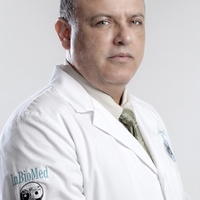




Uploads
Papers by Sabina Jhaumeer-laulloo